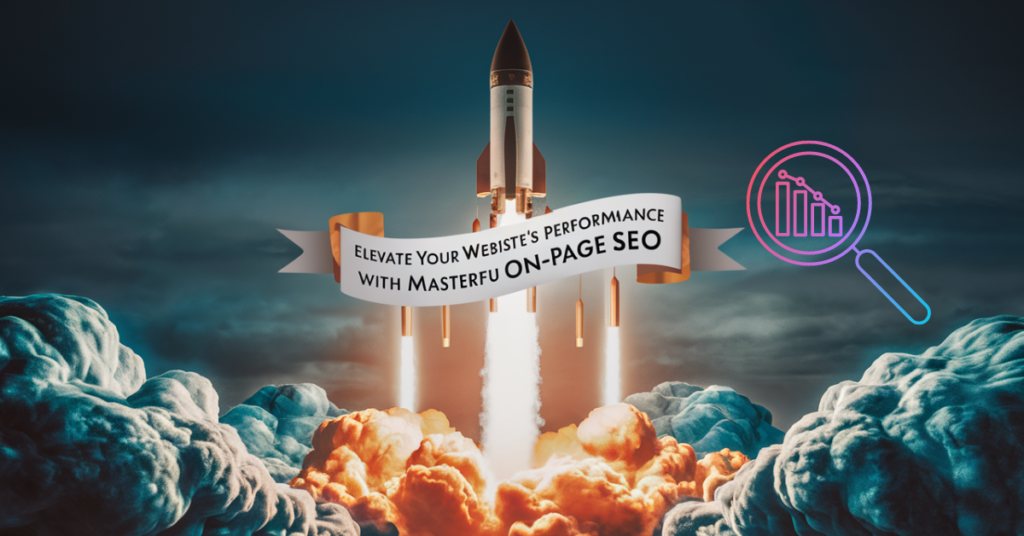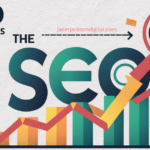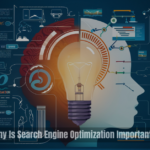Last Updated on June 23, 2025 by janetjacksondigital

On-Page SEO
Does your website struggle to get noticed in search results? Have you ever thought about how do you master SEO on-page to increase your online visibility and draw more organic visitors? Imagine leveraging the power of strategically placed keywords positioning and optimized meta tags to increase the efficiency of your website substantially.
On this article, we’ll explore the subject of on-page SEO, examining the most important strategies and methods that will transform your site to a magnet for search engines. From understanding the significance of on-page SEO for boosting results in search engine rankings, to implementing friendly practices for users such as meta descriptions and internal linking We’ve got you covered. Learn the secrets of efficient on-page SEO, and propel your site to new heights of internet visibility.
Let’s look at the vital importance of on-page SEO in improving your site’s rank in search results and find out how to implement the best techniques that appeal to both users as well as search engines. In the rapidly expanding field of internet marketing, having a solid understanding of SEO on-page is more important than ever. Are you prepared to optimize your site and see it rise in ranking of search results?
Introduction to SEO On-Page
In the vast world in digital advertising, On-Page SEO is seen as a crucial element optimizing websites to improve ranking in search engines and generating organic traffic. It combines a sophisticated mix of the content, technical optimization and enhancements to user experience in order to make sure that site’s pages are easy to find and beneficial for both search engines and users.
On-page SEO, as its name implies, is focused on enhancing various elements on your website pages. This includes SEO and keyword research for content quality and relevance the hierarchy of heading tags and structure and image optimization, external and internal links, mobile optimized schema markup and much more. Each of these components play a crucial role in increasing the visibility of your website’s page and relevance as well as the overall performance of SEO.
If you are able to implement the right on-page SEO methods, you will be able to ensure that your site is in line to the search engines such as Google and make it simpler for them to understand and rank your site’s content according to its relevancy to the user’s queries. In addition, it ensures that your websites provide users with a pleasant experience by providing relevant and accessible information.
With a thorough knowledge of the techniques used for on-page SEO will help you increase the visibility of your website’s results pages of search engines and increase organic traffic and eventually achieve your goals for digital marketing. Let’s now look into the essential aspects and best practices of on-page SEO so that you can unlock the maximum potential of your website’s optimization efforts.
Janet Jackson Dogital Helps To Grow your business to the next level.
What is On-Page SEO?
On-Page SEO is the methods and techniques of optimization used on websites to increase its relevancy and visibility in search results. It is focused on optimizing the individual pages of a website by following specific guidelines and strategies that search engines such as Google find crucial to rank.
Key Elements of On-Page SEO
1. Title Tags: They are HTML elements that form titles for a page. By including relevant keywords and creating distinctive, descriptive titles can geatly impact the search engine ranking as well as click-through rate for users.
2. Metatags: They are HTML elements that provide details about a website in search engines. Meta description, specifically, is a key element in generating clicks from the search engine result pages (SERPs).
3. Web page Content: Content on a website should be useful, relevant and well-structured. It is essential to include targeted keywords naturally, yet still making sure the content is interesting and offers useful information for the visitors.
4. Heading tags: Heading tags (H1 H1, H2, H3 and so on.) can help organize the content and show the structure of information displayed on a website. Using heading tags correctly can not only enhance the user experience, it can also help search engines recognize the arrangement of information.
Best Practices for On-Page SEO
1. Keyword optimization Keyword Optimization: Conduct extensive search for keywords to find keywords that have the greatest relevance and effective keywords that you can use on your pages. Use these keywords strategically in headers, meta descriptions and in the text.
2. User Experience: Prioritize the user experience by making sure your website loads quickly, is easy to navigate and mobile-friendly. This means improving the speed of loading pages and implementing a user-friendly navigation, and developing mobile-friendly designs.
3. High Quality Material: Create material that meets searchers’ needs by being informative, interesting, and high quality. Try to respond to their questions and provide valuable information. Avoid keyword stuffing and duplicate content, since it could negative impact rankings.
4. External and Internal Linking: Use internal links to link the pages of your site and improve the structure of your website. Also, add relevant external links to reliable sources to increase trustworthiness of the website’s content.
Keep in mind that the art of mastering SEO on-page is a continuous process that requires continual monitoring and optimisation. By adhering to these essential elements and the best techniques, you will increase the relevance and visibility of your website pages and ultimately improve the rankings of your website and increasing the amount of organic visitors.
Importance of On-Page SEO
In today’s world of digital on-page SEO is a key element in enhancing websites to improve ranking in search engines and enhancing the user experience overall. It is the process of enhancing various elements within your websites to ensure that they’re relevant as well as easy to search for search engine crawlers. What makes SEO on-page important? Let’s explore the importance of this.
Boost Search Engine Rankings
One of the main motives to prioritize SEO on-page is the direct effect on the search engine ranking. If you optimize your website pages using relevant keywords, meta tags and other elements on the page search engines will be able to better comprehend the content and place it in the appropriate order. By following the guidelines for best practices like optimizing your keywords, you improve the chance of your website pages being found in search results that are relevant which will drive greater organic traffic towards your website.
Improve User Experience
On-page SEO is also a crucial function in enhancing user experience of your website. If your website’s pages are optimized, with clearly defined and concise headings properly-organized content, and easy navigation, users are able to discover the information they’re searching for. This creates a pleasant user experience, which ultimately increases the chance of users staying longer on your website and engaging with your content and turning into customers or returning visitors.
Increase Click-Through Rates
On-page SEO that is effective can dramatically influence click-through rates on search engine result webpages (SERPs). If your Meta descriptions have been optimized by using captivating keywords and convincing copy, they are more appealing to visitors. They are enticed to click your link instead of other links, bringing an increase in organic visitors to your site.
Boost Online
Exposure Search engine crawlers will find your website more visible if you follow on-page SEO best practices. This means that search engines are able to browse and search your site more efficiently, resulting in greater rankings for your website in the search result. If your websites are easily found to search engines, they improve your chance of drawing organic traffic and reaching a larger public.
Stay Competitive in the Digital Landscape
On-page SEO is always changing as algorithms for search engines remain in flux. If you stay up-to-date with the most current techniques for SEO on pages to ensure that your site remains at the forefront of digital marketing. This lets you adapt to algorithm changes and optimize your content efficiently and ensure that it continues to rank highly in search results.
Through implementing the best practices and optimizing your website webpages with appropriate keywords and clear titles and a user-friendly experience you can improve your rankings on search engines and increase user engagement and increase the organic traffic to your site. Keep an eye out for us as we dive into further strategies and methods to aid you in mastering the art of SEO on-page in the next sections.
Keyword Research, and Optimization
Keyword research is a crucial element of SEO on-page and plays an important role in optimizing your site for better rankings in search engines. When you know the words and phrases people are using when searching for particular subjects and integrating relevant keywords into your site to enhance its relevance and rank in search results.
The Importance of Intensive Keyword Research
A thorough keyword analysis is vital since it can provide insights into the habits of searches of the people you want to reach. When you identify important and useful keywords that are relevant to your field and creating content that matches the requirements of users and matches their interests. This will ensure that your site will be seen by your intended audience when they are actively searching for answers or information.
Step-by-Step Guide for Effective Keyword Research
To conduct a successful keyword research, you must follow these steps:
1. Identify your ideal clientele: Find out the characteristics of your target market and the specific needs they have. Take into consideration their demographics, their interests and issues to adapt your keyword strategy to suit them.
2. Brainstorm keywords to start: Begin by creating an initial list of keyword ideas that are pertinent to your company or subject. These search terms will serve as the foundation for your inquiry.
3. Analyze the metrics of keywords: Analyze the volume of search and difficulty of the keyword as well as the competition for each keyword. Choose keywords with a more search volume and less competition to improve the chances of achieving a high rank.
4. Keywords with both short and long tails: Combine long-tail and short-tail keywords in your strategy. The longer-tail keyword is more targeted and are less competition, whereas short-tail keywords are broader and have more number of searches.
Keyword Optimization Techniques
After you’ve identified your desired keywords, you need to enhance your website’s elements on the page. Here are a few crucial points to think about:
1. Tags for titles: Include your targeted keywords naturally within the title tags on your websites. Make sure you’ve got your titles right to reflect the content and encourage users to click through the results of a search.
2. Metatags: Optimize your meta descriptions to include relevant keywords, and giving an easy summary of the content on your page. This makes it easier for search engines to determine how relevant your page is to the user’s inquiries.
3. Content on Web pages: Create content of high-quality that incorporates your targeted keywords naturally. Beware of keyword-stuffed content and concentrate on providing relevant information that meets the intent of searchers.
Remember that successful search engine optimization and keyword research requires constant monitoring and refinement in line with the search engines and the behavior of users change as time passes. By staying current and changing your strategy to keep up with the times to ensure that your site is optimized for higher results in organic search and traffic.
Content Quality and Relevance
The creation of relevant, high-quality content is a key element of a successful SEO on-page. It not only fulfills the desires of users however, it plays an important part in getting organic traffic to your site and boosting the rankings of search engines. In this article we will look at the importance of content quality and relevance to SEO on-page and offer guidelines on how to create captivating as well as informative material that will meet the requirements of your intended users.
Understanding User Intent
To ensure that your content is useful it is crucial to comprehend the purpose behind user’s searches. Make sure you research and examine the precise terms and expressions that people are using to find relevant information about your topic.
Research and Uncover Valuable Insights
Research is the basis for creating content that is of high-quality. Explore your subject area, gather current and accurate data, and back up your assertions with credible resources and sources. This will not only prove your knowledge but also increases the credibility of your material.
Engage and Inform
When writing content, you should aim to entertain the readers and educate them. Utilize a clear, professional and conversational tone to convey your ideas effectively. Divide your text into concise paragraphs, and add subheadings to increase the readability. Consider making use of bullet point or lists with numbers to organize your information and make it easier for your target audience.
Adjust for Your Desired Viewership
Make content specifically for the audience you wish to connect with. Take into consideration their prior experience and knowledge of the subject. For novices explain and define of the most important concepts. For more experienced readers concentrate on more advanced techniques or strategies.
You can better service your target audience’s needs and provide value through your content when you have a thorough understanding of them.
Optimize for Readability
In addition to relevancy in addition to readability, it is essential for on-page SEO. Avoid technical terms and jargon which could be confusing or disorient your readers. Remember, the objective is to clearly convey your message, and keep readers interested throughout their reading experience.
Producing relevant and high-quality content is crucial to ensure on-page SEO success. By understanding the intent of users by conducting extensive studies, educating and engaging your visitors, responding to their preferences, and focusing on the reader’s experience, you can write engaging content that not only satisfy search engines, but also offers the readers with value. Remember these suggestions as you design your SEO strategies for on-page and observe your website’s performance rise.
Heading Tag Hierarchy and Structure
Heading tags play an important part in structuring web page content and enhancing the content for SEO. They do more than help you in arranging your content, but they can also give valuable indications to the search engine regarding the importance and significance of the various sections of your website. In this article we will discuss the importance of heading tags and present guidelines for using the hierarchy of heading tags to boost the SEO of your site.
The Importance of Heading Tags
Heading tags, for example H1 or H2, H3, etc are used as signposts to provide both users and search engines through the information on your website. They establish the order of information, and enable readers to quickly look over and understand what is the basic structure and meaning of your web page. The search engines view heading tags as crucial ranking factors since they provide an understanding of the context and importance of the content.
In the case of heading tags it’s essential to utilize them in a hierarchical fashion. The H1 tag must serve as the primary title of the webpage. It must accurately summarize the contents. Subheadings can be identified by H2 tags, while further subdivisions can be made using H3 or H4, etc.
Best Practices for Heading Tag Hierarchy
Here are some of the best ways to utilize heading tag hierarchy efficiently:
1. Only use the H1 tag once per webpage: The H1 tag must clearly define the main subject or the primary focus for the site. It should be brief as well as descriptive. Also, it should contain relevant keywords.
2. Create subheadings for your content: Use H2 tags for subheadings to break down the main subject into segments. Subheadings should be able to give a clear flow of information.
3. Utilize H3 tags to further subdivisions: If you need to you need to, use H3 tags to separate your content into distinct sections. This will make it easier for visitors and search engines to understand the organization of the material on your website.
4. Use only the most appropriate heading tags: Although it is essential to utilize heading tags to organize your content, you should avoid using them too often. Make sure to reserve heading tags for relevant sections, not utilizing solely for formatting reasons.
5. Optimize heading tags to be SEO-friendly Include relevant keywords into the heading tag, particularly within the tags H1 and H2. Be sure that you prioritize reading experience and user-friendlyness over SEO optimization for keywords.
If you follow these guidelines to create a properly-structured website page, with clear headings that help users and indicate the importance of your site in search results. Be aware that heading tags aren’t just essential to SEO but they also improve the user experience overall by making your content accessible and easy to read.
Remember it is important to remember that heading tags represent only one aspect of SEO on-page and it is essential to think about other optimization strategies when implementing heading tags. In the subsequent sections, we’ll explore other important SEO practices which will enhance the performance of your site and increase its visibility in search results.
Image Optimization and Alt Text
Image optimization plays a vital function in enhancing SEO on the page and increasing the search engine effectiveness of your site. By optimizing your photos, you can make sure that they load fast and give relevant details to the search engine.
Here are some important guidelines and strategies for successful image optimization:
1. Select the appropriate file format Choose the appropriate formats for images like JPEG, PNG, or SVG based on the kind of image and the purpose for which it is. Condense the images to reduce the size of files without sacrificing quality.
2. Optimize the dimensions of your images Adjust the size of your images to your desired dimensions prior to uploading them to your site. This will improve the speed of loading and ensures that your images will fit within the layout of your page.
3. Use the descriptive names of your files Rename your image files using relevant and descriptive keywords which makes them easier for engines comprehend the information contained in the image. Use names like “on-page-seo-tips.jpg” instead of generic ones like “IMG001.jpg.”
4. Improve alt texts Alt text
which is also known as alternate text, provides a written description of the image to describe the image when it isn’t displayed. It is essential for accessibility and helps search engines decipher the text of the image. Incorporate relevant keyword phrases in your alt text but keep it short and clear.
5. Make use of descriptive captions Captions can provide more contextual information to your images and improve the engagement of users. Make sure your captions are clear, explain the picture, and contain pertinent keywords.
6. Optimize the size of your image files Make use of compression techniques or plug-ins to reduce the size of your photos without damaging the quality.
7. Utilize images sitemaps Create a sitemap of your image and upload your sitemaps to the search engines. This lets search engines comprehend and index your images better, increasing their search engine rankings.
When optimizing images, it is essential to strike a equilibrium between reducing the size of files while maintaining the image’s quality. If you follow these best practices for optimizing images and including descriptive alt text it will help you improve the effectiveness of your on-page SEO and boost the search engine popularity of your website.
Internal Linking as well as External Linking
Internal linking is an essential role in SEO (SEO) and enhancing the experience of users on your website. By strategically linking various pages on your site it will improve the site’s structure and navigation, which will ultimately lead to user engagement. Here are a few important things to keep in mind when you are implementing internal linking:
1. The Site’s Structure, Navigation and Internal links aid in creating an organized and logical website structure, which makes it simpler for crawlers of search engines and visitors to navigate your website. A well-structured internal link structure ensures that users can locate relevant content and seamlessly move between pages.
2. Distributing Link Authority: Internal links are used to distribute authority from link sources commonly referred to PageRank throughout your website. When you link from pages with high authority to other pages on your website, you are able to increase the rank potential of these pages, and boost your visibility on search results.
3. Setting up Content Relations: Internal linking lets you to establish connections between similar content on your website. By linking related pages search engines will be able to better assess the context and importance of your website’s content. This could positively impact your rankings in search results.
In the process of implementing internal linking, take note of these best methods:
– Use descriptive anchor text Include relevant keywords in your anchor text, to provide users as well as search engines with context regarding the content of the page linked to.
Link to relevant pages: Make sure that your pages linked to are thematically related and provide added value to the users. This enhances the user experience overall and will encourage users to visit more of your content.
External Linking
While internal linking is focused on linking pages on your site External linking is the process of linking to reputable and trustworthy websites that aren’t part of your own domain. External links add additional authenticity and context to your website’s content as well as allowing search engines to are able to take these into account when assessing the relevance and quality of your website.
This is why external links are important for SEO on the web:
1. Validation and Credibility Linking to trustworthy and credible external sources shows that your content has been thoroughly researched and trustworthy. This will increase your site’s trustworthiness to users as well as search engines.
2. In enhancing the relevance and depth of your content External links enable you to add additional resources and references that can be used to enhance your content. Through linking to reliable sources that cover specific areas, you can increase the general relevance and quality the content.
3. Building Relationships and Authority External linking can help build relationships with other respected websites within your field. If you link to useful content, there’s the possibility that these websites could reciprocate and hyperlink to your website which will increase your credibility and visibility.
If you are using external links, be sure to keep the following guidelines in your mind:
Select reliable and relevant Sites to Link To: Choose reliable and relevant trusted websites that can be relevant to your website’s content. Be sure that the external websites you hyperlink to are in alignment with the mission and objectives of your site.
Use Nofollow Attribute when You’re Unsure of the reliability of an external source, think about applying”nofollow” as a “nofollow” attribute on the link in order to not pass any SEO benefits to the website.
– Balance external and internal Links: Maintain a healthy balance between external and internal links to give a balanced user experience.
Implementing both external and internal linking to the on-page SEO strategy can greatly increase the authority, visibility of your site and the user experience.
Why Is SEO Crucial To Your Success Online?
Mobile Optimization and User Experience
In the present digital age mobile optimization plays an integral role in SEO on-page and the overall user experience. As the bulk of web traffic being generated by smartphones, it’s vital that websites provide an enjoyable and seamless experience for users on mobile devices. Here are some top methods to optimize your website for mobile devices and providing satisfaction for your users.
Responsive Design
Implementing an adaptive design is the foundation for mobile-optimized. It means that your site alters and adapts the layout of its content and design to suit different screen sizes and resolutions. By using responsive designs your site will look and function flawlessly across various mobile devices, creating an identical experience for visitors.
Fast Loading Speed
Users of mobile devices have very high standards regarding loading speed. Slow loading websites could result in higher bounce rates, and a negative effect on user experience. To boost the speed at which your website loads when using mobiles, consider compressing images, reducing CSS as well as JavaScript documents and using the caching features in your internet browser.
Touch-Friendly Interface
Mobile devices let users browse through touchscreens. It’s crucial to design your website using a the user in mind, making sure that links and buttons are easy to tap and placed in the right order. The large and well-defined touchscreens make it easy the users can interact on your website which improves their overall experience.
Streamlined Navigation
Mobile users generally have a limited screen space It’s therefore essential to optimize the navigation of your site for mobile devices. Reduce the structure of your menus prioritizing the top crucial areas and pages. Think about the use of an interactive navigation menu that is visible while users scroll and provides users with easy access to the most important web pages.
Optimized Content Display
When optimizing your mobile site take into consideration how your content will appear. Break big text blocks into smaller paragraphs, or use bullet points or lists of numbers to improve accessibility, and ensure that the font sizes you choose to use can be read on smaller displays. Also, think about using a line length that is easily read to avoid excessive scrolling by users.
Mobile-Friendly Forms
If your site has fields or forms that require input from users be sure that they’re mobile-friendly. Make use of input options that are suitable to mobile phones, for instance numbers, email or dates. Make sure that the fields on your form and buttons are correctly designed and easy to work with using touchscreens. You might consider using autofill to make filling out forms easier.
In the end mobile optimization isn’t solely important for SEO on the page but also to provide an outstanding user experience. By using responsive designs, optimizing loading speeds and creating a user-friendly interface by streamlining navigation, improving display of content, and making sure to use the use of mobile-friendly forms, you can increase the efficiency of your website and entice and keep users who are mobile efficiently.
Remember that the effectiveness of your web presence is contingent on providing users with a smooth and easy experience on all devices. By focusing on the mobile experience, you’ll not just enhance your SEO on the page, but also create a positive customer experience, which keeps your visitors interested and encourages them to browse or interact with your website’s content.
Why You Need an SEO Specialist for Your Website?
Schema Markup Implementation
Schema markup plays a vital function in enhancing accessibility of site’s pages in search results webpages (SERPs) and delivering rich snippets of information. If you use schema markup in the right way it can help make your websites stand out and provide visitors with useful details at glance. Here are some tips to assist you in using on-page SEO using schema markup.
Understand the Basics of Schema Markup
Before you begin the implementation process it’s important to acquire a thorough knowledge about what schema markup actually is and how it functions. Schema markup is a term for a code that is put to websites to provide additional context for your content to search engines. It makes use of structured data vocabularies that are recognized by search engines, like Schema.org to define the particular elements of your site.
Choose Relevant Schema Types
To maximize the benefits of schema markup, choose the right schema types that relate to the content of your site. Schema.org provides a variety of schema types that can be used for various reasons, such as products, articles such as events, local business and many more. Select those schemas that are compatible with the content you intend to publish. content in order to give accurate information for search engine crawlers.
Use JSON-LD to implement Schema Markups.
For schema markup, JSON-LD (JavaScript Object Notation for Linked Data) is the recommended standard. It lets search engines quickly comprehend and interpret the structured data that you have on your website. Utilize the JSON-LD format to add the required schema markups to the HTML code.
Leverage Key Schema Properties
When creating schema markup, you should focus on using the primary properties that pertain for the type of schema you’ve selected. Each schema type comes with particular properties that offer specific data that search engines can use. Responsive Design Implementing an adaptive design is the foundation for mobile-optimized.
Test and Validate Your Schema Markup
After the schema markup has been implemented it is essential to verify and test the accuracy of the markup. Utilize tools such as that of the Google Structured Data Testing Tool to look for issues or warnings. This will ensure that search engines are able to correctly interpret your schema markup and show rich snippets of your schema in results.
When you implement schema markup in a way that is effective to improve accessibility of website pages, give useful information to visitors as well as improve the overall effectiveness of your on-page SEO efforts. Do not overlook this crucial aspect of optimizing your on-page since it could play a crucial part in driving traffic from organic sources to your site.
On-Page SEO Checklist and Tools
In order to achieve the best on-page SEO and increase your site’s ranking on search engines it is crucial to follow the complete checklist of elements and use the appropriate tools. This checklist will help you along with some suggested tools and resources to aid you in implementing efficient SEO on-page techniques.
1. Keyword Research and Optimization
– Conduct a thorough research on keywords with tools such as Rank Math or Google’s Keyword Planner.
Find the keywords appropriate to what you’re looking for and have large search volumes and low competition.
Optimize your meta tags and web pages with carefully selected keywords that increase your relevancy and search engine visibility.
2. Content Quality and Relevance
Create relevant and high-quality content that is able to satisfy the needs of your intended users.
Compose interesting and educational pieces that answer the queries of your readers and offer value.
Ensure that your content is unique complete, thorough, and well-researched.
3. Heading Tag Hierarchy and Structure
Use heading tags (H1, H2, and H3 and so on.) to organize your website’s information.
Maintain a logical structure by using H1 as the primary title, then H2 for headings of sections, and then on.
Providing clear alt text and optimizing your photographs will aid search engines in effectively indexing and ranking your photos.
4. Image Optimization and Alt Text
Optimize your photos by reducing their size without compromising the quality.
Make descriptive file names for images, and include an alt-text that is precise about the content of the image.
Optimized images can increase the speed of loading websites and offer an alternative view for search engines.
5. Linking Internally and Externally
Search engines can better comprehend the structure of your website with the aid of internal linking.
Incorporate pertinent internal links in your content. These links will direct visitors to relevant articles or pages on your site.
External links to trusted sources can increase confidence in your blog and give more value to your readers.
6. Mobile Optimization and User Experience
Make your website mobile-friendly devices to be able to handle the ever-growing amount of mobile users.
Check that your site loads swiftly on devices with mobile capabilities.
– Provide a smooth user experience for mobile users by enhancing interactivity, readability, and navigation.
7. Schema Markup Implementation
Implement schema markup in order to improve search visibility as well as provide rich snippets of search results.
Use schema markups to give additional information on products reviews, events and more.
Schema markup is a method to assist search engines understand the significance and context of your website’s content.
8. On-Page SEO Checklist Tools and Resources
Rank Math: A mighty SEO plugin that offers complete On-Page SEO evaluation and tools for optimization.
Google Search Console: Track your site’s performance, monitor keywords, and find potential SEO opportunities that are on the page.
Moz: Offers a range of SEO tools that can help improve the optimization of your site, such as search engine optimization as well as site audits.
SEMrush: Provides deep keyword research and SEO on-page analysis and analysis of competitive factors.
Yoast SEO: is one of the most popular WordPress plugin that provides SEO information on the web and also optimization tips.
Keep in mind that using these on-page SEO strategies along with valuable information and a deep knowledge about SEO best practices can assist you in improving your results in search engine ranking and also increase organic traffic to your website.
Conclusion
The art of mastering on-page SEO is vital for optimizing the performance of your website and getting higher ranking on search engines.
In this complete guide, we’ve discussed different aspects of on-page SEO that include search engine optimization and keyword research as well as content quality and relevancy the hierarchy of heading tags and structure and image optimization, alt text, both external and internal linking mobile optimization, user experience schema markup and implementation and the application of SEO tools on the page.
Conducting a thorough research on keywords while also optimizing your site’s meta tags, title tags, and your content to include relevant keywords, you’ll be able to improve your the results of search engines. Making high-quality, informative content that meets the needs of searchers is vital to engage the audience and improving your rankings in search results.
The proper structure of your website’s by using the heading tag and optimizing these for SEO will help search engines comprehend the structure and importance of your website’s content. While external linking boosts the legitimacy and reliability of your website, internal linking improves the navigation and structure of your site. Design that is responsive and mobile-friendly ensures that users will have a consistent experience on different devices.

My name is Janet Jackson Seo and I work as a SEO Expert. I appreciate the process of developing an innovative approach and employing logic, particularly when it concerns future studies and SEO optimization. As an SEO expert I have known how to set up SEO campaigns fully and how to monitor their achievements.





